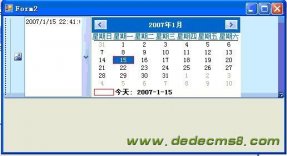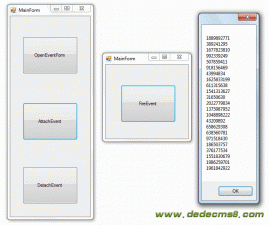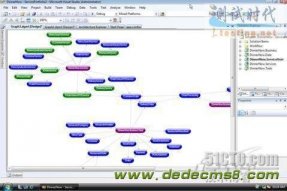前言:本篇主要讲述等待task执行完成。
本篇的议题如下:
1. 等待Task执行完成
2. Task中的异常处理
首先注意一点:这里提到的"等待"和之前文章提到的"休眠"意思是不一样的:
等待:在等待一个task的时候,这个task还是在运行之中的,"等待"相当于在监听运行的task的执行情况。
休眠:让tasku不运行。
在上篇文章中介绍了如果从Task中获取执行后的结果:在Task执行完成之后调用Task.Result获取。其实也可以用其他的方法等待Task执行完成而不获取结果,这是很有用的:如果你想等待一个task完成之后再去做其他的事情。而且我们还可以等待一个task执行完成,或者等待所有的task执行完成,或者等待很多task中的一个执行完成。因为Task是由内部的Scheduler管理的,调用wait方法,其实就是我们在监控task的执行,看看这个task是否执行完了,如果完成,那么wanit方法就返回true,反之。
1. 等待Task执行完成
1.1等待单独的一个Task执行完成
我们可以用Wait()方法来一直等待一个Task执行完成。当task执行完成,或者被cancel,或者抛出异常,这个方法才会返回。可以使用Wait()方法的不同重载。举个例子:
static void Main(string[] args)
{
// create the cancellation token source
CancellationTokenSource tokenSource = new CancellationTokenSource();
// create the cancellation token
CancellationToken token = tokenSource.Token;
// create and start the first task, which we will let run fully
Task task = createTask(token);
task.Start();
// wait for the task
Console.WriteLine("Waiting for task to complete.");
task.Wait();
Console.WriteLine("Task Completed.");
// create and start another task
task = createTask(token);
task.Start();
Console.WriteLine("Waiting 2 secs for task to complete.");
bool completed = task.Wait(2000);
Console.WriteLine("Wait ended - task completed: {0}", completed);
// create and start another task
task = createTask(token);
task.Start();
Console.WriteLine("Waiting 2 secs for task to complete.");
completed = task.Wait(2000, token);
Console.WriteLine("Wait ended - task completed: {0} task cancelled {1}",
completed, task.IsCanceled);
// wait for input before exiting
Console.WriteLine("Main method complete. Press enter to finish.");
Console.ReadLine();
}
static Task createTask(CancellationToken token)
{
return new Task(() =>
{
for (int i = 0; i < 5; i++)
{
// check for task cancellation
token.ThrowIfCancellationRequested();
// print out a message
Console.WriteLine("Task - Int value {0}", i);
// put the task to sleep for 1 second
token.WaitHandle.WaitOne(1000);
}
}, token);
}
从上面的例子可以看出,wait方法子task执行完成之后会返回true。
注意:当在执行的task内部抛出了异常之后,这个异常在调用wait方法时会被再次抛出。后面再"异常处理篇"会讲述。
1.2.等待多个task
我们也可以用WaitAll()方法来一直到等待多个task执行完成。只有当所有的task执行完成,或者被cancel,或者抛出异常,这个方法才会返回。WiatAll()方法和Wait()方法一样有一些重载。
注意:如果在等在的多个task之中,有一个task抛出了异常,那么调用WaitAll()方法时就会抛出异常。
static void Main(string[] args)
{
// create the cancellation token source
CancellationTokenSource tokenSource = new CancellationTokenSource();
// create the cancellation token
CancellationToken token = tokenSource.Token;
// create the tasks
Task task1 = new Task(() =>
{
for (int i = 0; i < 5; i++)
{
// check for task cancellation
token.ThrowIfCancellationRequested();
// print out a message
Console.WriteLine("Task 1 - Int value {0}", i);
// put the task to sleep for 1 second
token.WaitHandle.WaitOne(1000);
}
Console.WriteLine("Task 1 complete");
}, token);
Task task2 = new Task(() =>
{
Console.WriteLine("Task 2 complete");
}, token);
// start the tasks
task1.Start();
task2.Start();
// wait for the tasks
Console.WriteLine("Waiting for tasks to complete.");
Task.WaitAll(task1, task2);
Console.WriteLine("Tasks Completed.");
// wait for input before exiting
Console.WriteLine("Main method complete. Press enter to finish.");
Console.ReadLine();
}
在上面的例子中,首先创建了两个task,注意我们创建的是可以被cancel的task,因为使用CancellationToken。而且在第一个task中还是用waitOne()休眠方法,其实目的很简单:使得这个task的运行时间长一点而已。之后我们就调用了WaitAll()方法,这个方法一直到两个task执行完成之后才会返回的。1.3.等待多个task中的一个task执行完成
可以用WaitAny()方法来等待多个task中的一个task执行完成。通俗的讲就是:有很多的task在运行,调用了WaitAny()方法之后,只要那些运行的task其中有一个运行完成了,那么WaitAny()就返回了。
static void Main(string[] args)
{
// create the cancellation token source
CancellationTokenSource tokenSource = new CancellationTokenSource();
// create the cancellation token
CancellationToken token = tokenSource.Token;
// create the tasks
Task task1 = new Task(() =>
{
for (int i = 0; i < 5; i++)
{
// check for task cancellation
token.ThrowIfCancellationRequested();
// print out a message
Console.WriteLine("Task 1 - Int value {0}", i);
// put the task to sleep for 1 second
token.WaitHandle.WaitOne(1000);
}
Console.WriteLine("Task 1 complete");
}, token);
Task task2 = new Task(() =>
{
Console.WriteLine("Task 2 complete");
}, token);
// start the tasks
task1.Start();
task2.Start();
// wait for the tasks
Console.WriteLine("Waiting for tasks to complete.");
int taskIndex = Task.WaitAny(task1, task2);
Console.WriteLine("Task Completed. Index: {0}", taskIndex);
// wait for input before exiting
Console.WriteLine("Main method complete. Press enter to finish.");
Console.ReadLine();
}
2. Task中的异常处理
在并行编程(TPL)中另外一个已经标准化了的操作就是"异常处理"。而且在并行编程中异常处理显得尤为重要,因为并行编程时与系统中的线程相关的,出了异常,你开发的程序就很有可能崩溃。
下面就详细介绍TPL中异常处理操作。
a.处理基本的异常。
在操作task的时候,只要出现了异常,.NET Framework就会把这些异常记录下来。例如在执行Task.Wait(),Task.WaitAll(),Task.WaitAny(),Task.Result.不管那里出现了异常,最后抛出的就是一个System.AggregateException.
System.AggregateException时用来包装一个或者多个异常的,这个类时很有用的,特别是在调用Task.WaitAll()方法时。因为在Task.WaitAll()是等待多个task执行完成,如果有任意task执行出了异常,那么这个异常就会被记录在System.AggregateException中,不同的task可能抛出的异常不同,但是这些异常都会被记录下来。
下面就是给出一个例子:在例子中,创建了两个task,它们都抛出异常。然后主线程开始运行task,并且调用WaitAll()方法,然后就捕获抛出的System.AggregateException,显示详细信息。
static void Main(string[] args)
{
// create the tasks
Task task1 = new Task(() =>
{
ArgumentOutOfRangeException exception = new ArgumentOutOfRangeException();
exception.Source = "task1";
throw exception;
});
Task task2 = new Task(() =>
{
throw new NullReferenceException();
});
Task task3 = new Task(() =>
{
Console.WriteLine("Hello from Task 3");
});
// start the tasks
task1.Start(); task2.Start(); task3.Start();
// wait for all of the tasks to complete
// and wrap the method in a try...catch block
try
{
Task.WaitAll(task1, task2, task3);
}
catch (AggregateException ex)
{
// enumerate the exceptions that have been aggregated
foreach (Exception inner in ex.InnerExceptions)
{
Console.WriteLine("Exception type {0} from {1}",
inner.GetType(), inner.Source);
}
}
// wait for input before exiting
Console.WriteLine("Main method complete. Press enter to finish.");
Console.ReadLine();
}
从上面的例子可以看出,为了获得被包装起来的异常,需要调用System.AggregateException的InnerExceptions属性,这个属性返回一个异常的集合,然后就可以遍历这个集合。
而且从上面的例子可以看到:Exeception.Source属性被用来指明task1的异常时ArgumentOutRangeException.
b.使用迭代的异常处理Handler
一般情况下,我们需要区分哪些异常需要处理,而哪些异常需要继续往上传递。AggregateException类提供了一个Handle()方法,我们可以用这个方法来处理
AggregateException中的每一个异常。在这个Handle()方法中,返回true就表明,这个异常我们已经处理了,不用抛出,反之。
在下面的例子中,抛出了一个OperationCancelException,在之前的task的取消一文中,已经提到过:当在task中抛出这个异常的时候,实际上就是这个task发送了取消的请求。下面的代码中,描述了如果在AggregateException.Handle()中处理不同的异常。
static void Main(string[] args)
{
// create the cancellation token source and the token
CancellationTokenSource tokenSource = new CancellationTokenSource();
CancellationToken token = tokenSource.Token;
// create a task that waits on the cancellation token
Task task1 = new Task(() =>
{
// wait forever or until the token is cancelled
token.WaitHandle.WaitOne(-1);
// throw an exception to acknowledge the cancellation
throw new OperationCanceledException(token);
}, token);
// create a task that throws an exception
Task task2 = new Task(() =>
{
throw new NullReferenceException();
});
// start the tasks
task1.Start(); task2.Start();
// cancel the token
tokenSource.Cancel();
// wait on the tasks and catch any exceptions
try
{
Task.WaitAll(task1, task2);
}
catch (AggregateException ex)
{
// iterate through the inner exceptions using
// the handle method
ex.Handle((inner) =>
{
if (inner is OperationCanceledException)
{
// ...handle task cancellation...
return true;
}
else
{
// this is an exception we don't know how
// to handle, so return false
return false;
}
});
}
// wait for input before exiting
Console.WriteLine("Main method complete. Press enter to finish.");
Console.ReadLine();
}







